The ASRock DeskMini A300 Review: An Affordable DIY AMD Ryzen mini-PC
by Ganesh T S on April 26, 2019 8:00 AM ESTGPU Performance - Gaming Workloads
Our revamped gaming test suite for 2018 involves six different games:
- Civlization VI (DX12)
- Dota 2
- F1 2017
- Grand Theft Auto V
- Middle Earth: Shadow of War
- Far Cry 5
Most system reviews take a handful of games and process them at one resolution / quality settings for comparison purposes. Recently, we have seen many pre-built systems coming out with varying gaming capabilities. Hence, it has become imperative to give consumers an idea of how a given system performs over a range of resolutions and quality settings for each game. With our latest suite, we are able to address this aspect.
Civilization VI (DX12)
The Civilization series of turn-based strategy games is very popular. For such games, the frame rate is not necessarily an important factor in the gaming experience. However, with Civilization VI, Firaxis has cranked up the visual fidelity to make the game more attractive. As a result, the game can be taxing on the GPU as well as the CPU, particularly in the DirectX 12 mode.
| Civilization VI (DirectX 12) Performance | |||
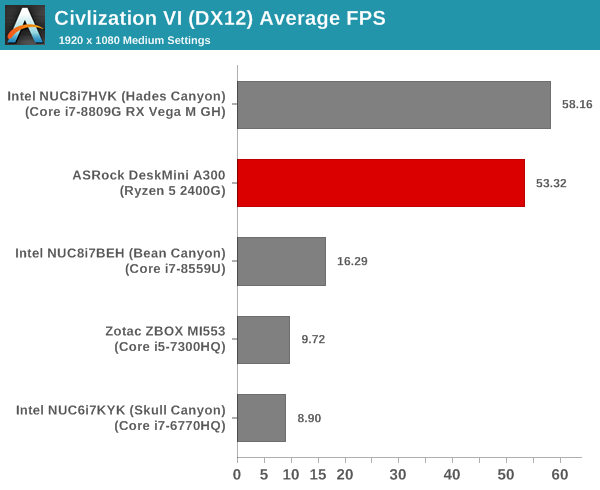
We processed the built-in benchmark at two different resolutions (1080p and 2160p), and with two different quality settings (medium and ultra, with the exact differences detailed here). At both resolutions and quality settings, we find the DeskMini A300 with a significant lead over other systems with integrated GPUs.
Dota 2
Dota 2 has been featuring in our mini-PC and notebook reviews for a few years now, but, it still continues to be a very relevant game. Our evaluation was limited to a custom replay file at 1080p resolution with enthusiast settings ('best-looking' preset). We have now revamped our testing to include multiple resolutions - This brings out the fact that the game is CPU-limited in many configurations.
Dota 2 allows for multiple renderers - we use the DirectX 11 mode. The rendering settings are set to 'enthusiast level' (best-looking, which has all options turned on, and at Ultra level, except for the Shadow Quality set to 'High'). We cycle through different resolutions after setting the monitor resolution to match the desired resolution. The core scripts and replay files are sourced from Jonathan Liebig's original Dota 2 benchmarking instructions which used a sequence of frames from Match 3061101068.
| Dota 2 - Enthusiast Quality Performance | |||
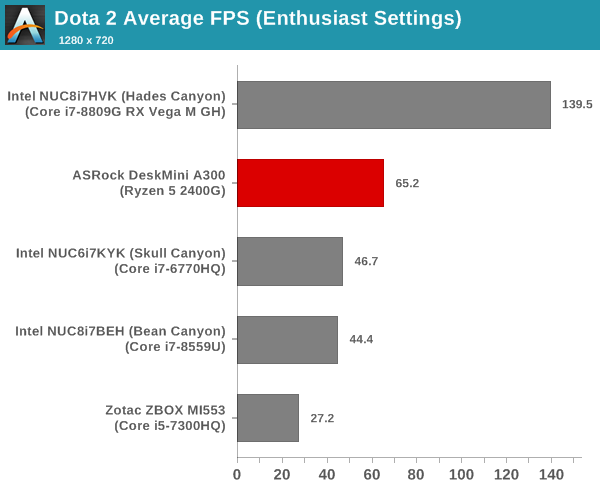
CPU-limited, or not, the same results of the DeskMini A300 being the best integrated GPU-system of the lot holds true for Dota 2 also.
F1 2017
Our gaming system reviews have always had a representative racing game in it. While our previous benchmark suite for PCs featured Dirt 2, we have moved on to the more recent F1 2017 from Codemasters for our revamp.
| F1 2017 - Ultra Quality Performance | |||
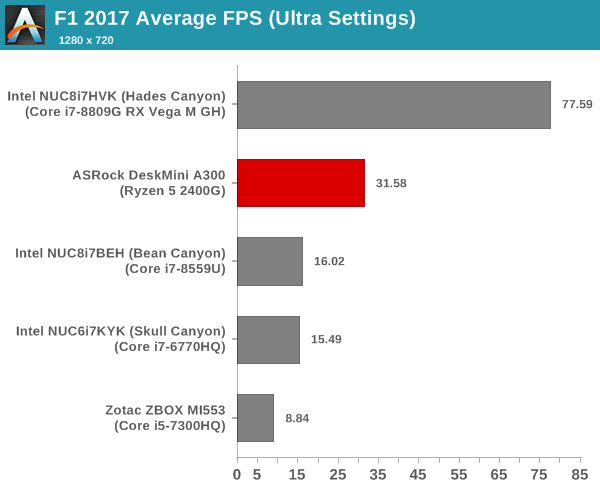
The supplied example benchmark (with some minor tweaks) is processed at four different resolutions while maintaining the graphics settings at the built-in 'Ultra' level. We don't see any surprises in this game's benchmarks.
Grand Theft Auto V
GTA doesn’t provide graphical presets, but opens up the options to users and extends the boundaries by pushing even the hardest systems to the limit using Rockstar’s Advanced Game Engine under DirectX 11. Whether the user is flying high in the mountains with long draw distances or dealing with assorted trash in the city, when cranked up to maximum it creates stunning visuals but hard work for both the CPU and the GPU. For our test we have scripted a version of the in-game benchmark. The in-game benchmark consists of five scenarios: four short panning shots with varying lighting and weather effects, and a fifth action sequence that lasts around 90 seconds. We use only the final part of the benchmark, which combines a flight scene in a jet followed by an inner city drive-by through several intersections followed by ramming a tanker that explodes, causing other cars to explode as well. This is a mix of distance rendering followed by a detailed near-rendering action sequence.
| Grand Theft Auto V Performance | |||
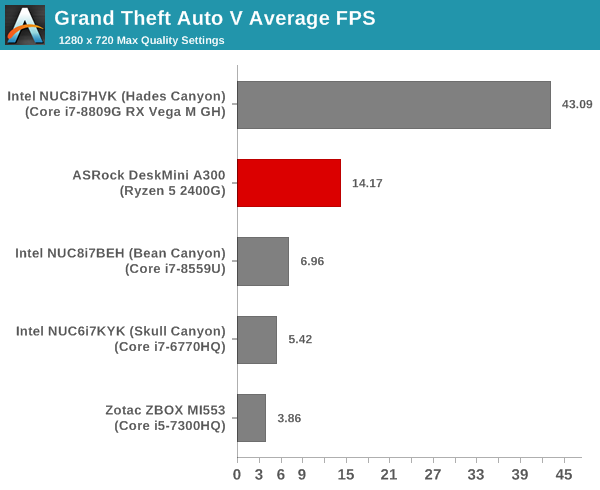
We processed the benchmark across various resolutions and quality settings (detailed here). The results are presented above. At the risk of sounding like a broken record, the DeskMini A300 again turns out to be the best iGPU-only system in our list.
Middle Earth: Shadow of War
Middle Earth: Shadow of War is an action RPG. In our previous gaming benchmarks suite, we used its prequel - Shadow of Mordor. Produced by Monolith and using the new LithTech Firebird engine and numerous detail add-ons, Shadow of War goes for detail and complexity. The graphics settings include standard options such as Graphical Quality, Lighting, Mesh, Motion Blur, Shadow Quality, Textures, Vegetation Range, Depth of Field, Transparency and Tessellation. There are standard presets as well. The game also includes a 'Dynamic Resolution' option that automatically alters graphics quality to hit a pre-set frame rate. We benchmarked the game at four different resolutions - 4K, 1440p, 1080p, and 720p. Two standard presets - Ultra and Medium - were used at each resolution after turning off the dynamic resolution option.
| Middle Earth: Shadow of War Performance | |||
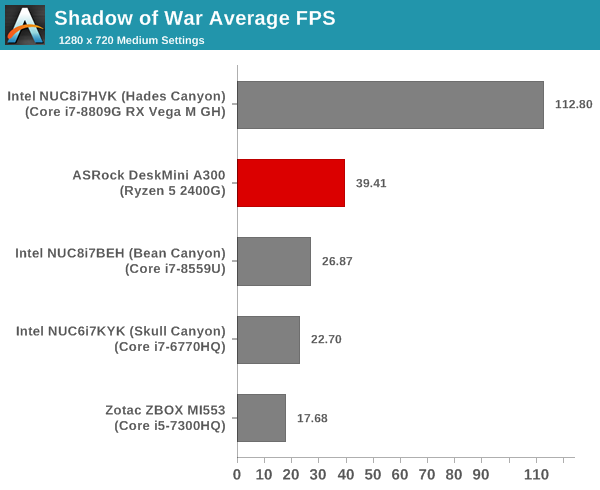
The relative numbers are no different from what was observed in the other games.
Far Cry 5
Ubisoft's Far Cry 5 is an action-adventure first-person shooter game released in March 2018. The game comes with an in-built benchmark and has standard pre-sets for quality settings. We benchmarked the game at four different resolutions - 720p, 1080p, 1440p, and 2160p. Two preset quality settings were processed at each resolution - normal and ultra.
| Far Cry 5 Performance | |||
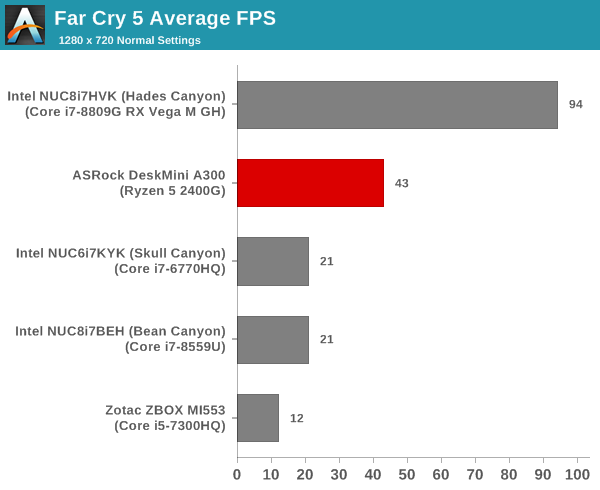
Overall, the DeskMini A300 with the Ryzen 5 2400G emerges as a clear-cut winner for folks looking to game without a discrete GPU. Even the best iGPU that Intel can offer in the Iris Plus series is unable to approach the Vega 11 GPU integrated into the Ryzen processor.










88 Comments
View All Comments
BigMamaInHouse - Friday, April 26, 2019 - link
Comparing 2400G with Real iGPU vs $431 i7-8559U - I'd say it performs Great!.Irata - Friday, April 26, 2019 - link
To be more specific, on the "productivity benchmark", the A300 has 89% of the A310's score with 86% of its power consumption, so for office type tasks, it is actually a bit more efficient.ganeshts - Friday, April 26, 2019 - link
Ah, the pitfalls of saying ProdA scores X% of ProdB in metric M at Y% in metric N, when M and N are not linearly correlated!Extending it the same way, if I were to build the DeskMini 310 system with the same original review components at the current prices, I am going to splurge : 162 (DeskMini 310 board with Wi-Fi compared to DeskMini A300 without Wi-Fi) + 139 (Core i3-8100) + 76 (DDR4-2400 2x8GB SODIMM) + 78 (PCIe 3.0 x4 240GB NVMe SSD - Corsair Force MP510) = $455 ; Let me look up the table for the DeskMini A300 cost without Wi-Fi - tada, it is $465 - oh oh oh!!!! Does the lower upfront cost for the AMD system (as claimed in the article in the same BAPCo section) evaporate into thin air? No!
The reason is that when you are looking at SYSmark 2018 scores and SYSmark 2018 energy consumption numbers, you compare against systems that score approximately the same in those particular metrics.
For the overall SYSmark 2018 scores, the DeskMini A300 is approximately the same as the Baby Canyon NUC - then, let us look at the energy consumption numbers for those two - the Baby Canyon consumes lesser energy.
For the energy consumption numbers, the A300 and 310 are approximately in the same ball park - and there, you see the the 310 with a higher score.
As for accusations that 'Intel CAN"T be shown in anything other than their best light' - take a chill pill - the PCMark 8 numbers back up SYSmark 2018. And, in the gaming section, we show that AMD outperforms the best that Intel can offer. As an impartial reviewer, my aim is to present the facts as-is and provide my analysis - if you come with pre-conceived notions that one product / vendor is better than the other, then, no amount of facts will convince you otherwise.
Irata - Friday, April 26, 2019 - link
Replying to two different comments with one reply is a bit unfortunate as another poster made the "Intel can't be shown in..." comment.As for the price, if you check Newegg, the $150 A300 does include a Wifi kit.
Looking at Newegg prices, I get the following:
Desk Mini 300: $150
Desk Mini 310: $168
Ryzen 2400G: $150
Core i3-8100: $142
Memory: 100 (for the AMD system) vs. 80 (for the Intel based one)
note: I had a hard time finding the exact memory so I was looking at Team Group memory with roughly the same specs
WDS500G1B0C: $78
Corsair FORCE MP500: $130
When possible, in stock retail items with free shipping were chosen.
This gives me a total of $ 478 for the Desk Mini 300 (including WiFi) and $ 520 for the 310. But calling the price even would be OK, considering how prices can fluctuate.
MASSAMKULABOX - Monday, December 9, 2019 - link
AMd 150 + 150 +100 = $400INT $168 + 142 + 80 = $ 390 ... makes Intel cheaper , ..altho at this late date you can get the 2400g for $120 or less
Irata - Friday, April 26, 2019 - link
Second reply as I wanted to keep things separately.As I stated below, the comment regarding Intel having to be shown in the best light was made by another poster. Why could (she) have said this ?
For one, Intel is a client of your parent company Purch. They even mention this on their web site under "experience", stating "We’re focused on serving our action-oriented audience, as well as elevating the sponsor’s brand with that audience. We tailor the Native content that runs across our sites to better suit each environment, while keeping the integrity of the sponsor’s original content and brand."
In addition, you are using Bapco Sysmark, a benchmark that - given this "organization's" history - leaves a rather bad taste.
Now, I am not attacking your personal or journalistic integrity, however you must admit that the though AT may not be impartial does cross ones mind.
And this does not have to be overly obvious shilling (as that would be counter productive), but can be small nuances or tones, stressing one thing while leaving out another.
Do I have a pre-concieved notion of which one is better ?
Besides seeing the Intel iGPU as inferior (with the exception of video encode / decode) not really, but I admit that I do not particularly like Intel as a company
Ryan Smith - Friday, April 26, 2019 - link
"Now, I am not attacking your personal or journalistic integrity, however you must admit that the though AT may not be impartial does cross ones mind."Above all else, I think people vastly overestimate both how much work vendors are willing to put in, and how much they actually care about AnandTech. Being underhanded is a lot of work, especially for as small an audience as AnandTech has.
To be sure, there is a significant editorial firewall up between ad sales and editorial. I honestly couldn't even tell you about our (former) publisher's comments, because none of that ever involved AnandTech. It was probably a campaign that ran on Tom's Guide or such.
But regardless, we don't do shenanigans, and I won't stand for them. Vendors don't get to see articles early, we don't let vendors buy preferential treatment, and any sponsored content is going to be very clearly labeled as such. All AnandTech has its its honesty; so to sacrifice that would cost us everything.
Which, to loop back to the discussion of Sysmark, Ganesh uses it as part of his mini-PC evaluations. It's a pretty useful benchmark, especially for the energy efficiency metrics. It works well for what Ganesh needs, and the workloads seem reasonable. At the same time we're well-aware of the controversy surrounding it, and we'd never trust a single benchmark for a review - and certainly not Sysmark. Which is why we run many benchmarks, to look at different workloads and get different points of view on performance.
Irata - Saturday, April 27, 2019 - link
Thanks for the clarification Ryan. I still think that Sysmark is a no-go, but that's just my personal opinion.Smell This - Friday, April 26, 2019 - link
*As an impartial reviewer*_____________________
I snorted.
BPB - Friday, April 26, 2019 - link
I have one of these, and really like it. My problem is I bought this to replace an older NUC, and the older NUC runs Windows 8.1. I use the older NUC for WMC. Obviously the DeskMini doesn't support 8.1, but I thought I could get it to run 7. I can't. I noticed that ASRock has a utility for installing Windows 7 on AM4 motherboards, and I was given the impression that ASRock would update the DeskMini BIOS so I could install Windows 7. Then I found out the 2400G is only Windows 10 compatible. I don't know how I missed that when I did my research... So, my son gets nice little PC to replace his older one. This is a nice little setup, I just wish Windows 10 had something even 80 percent as good as WMC.